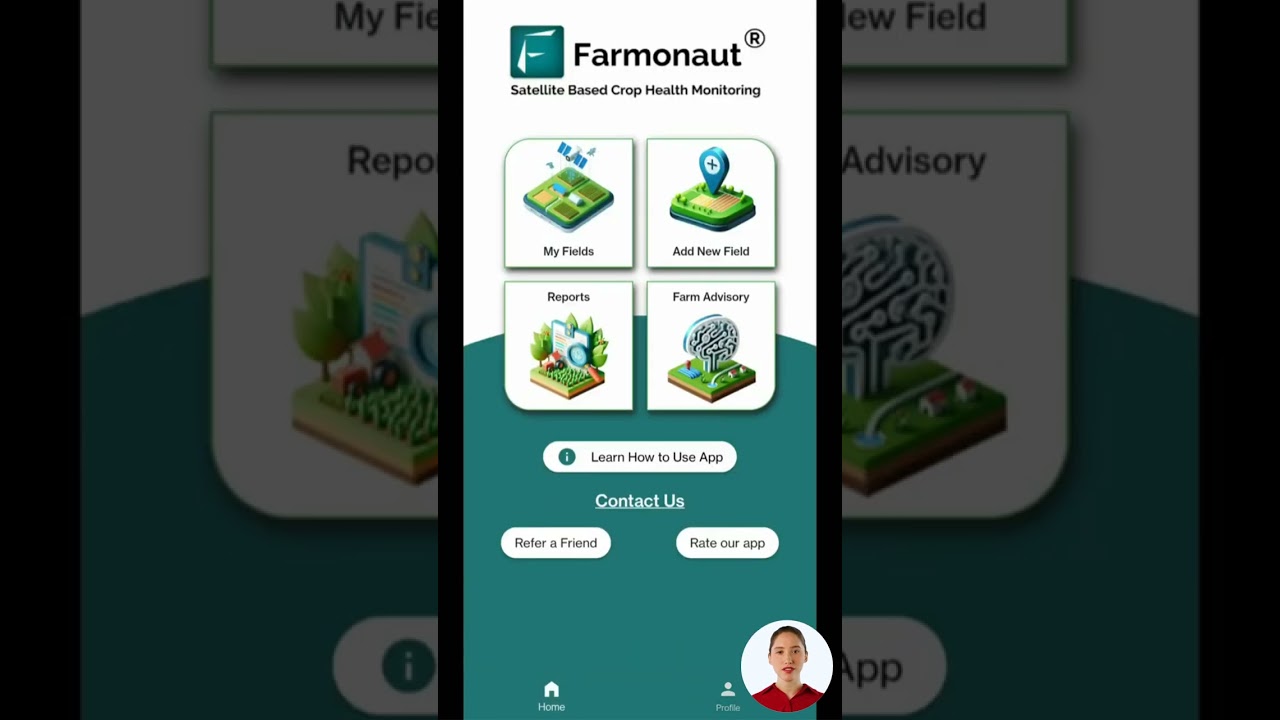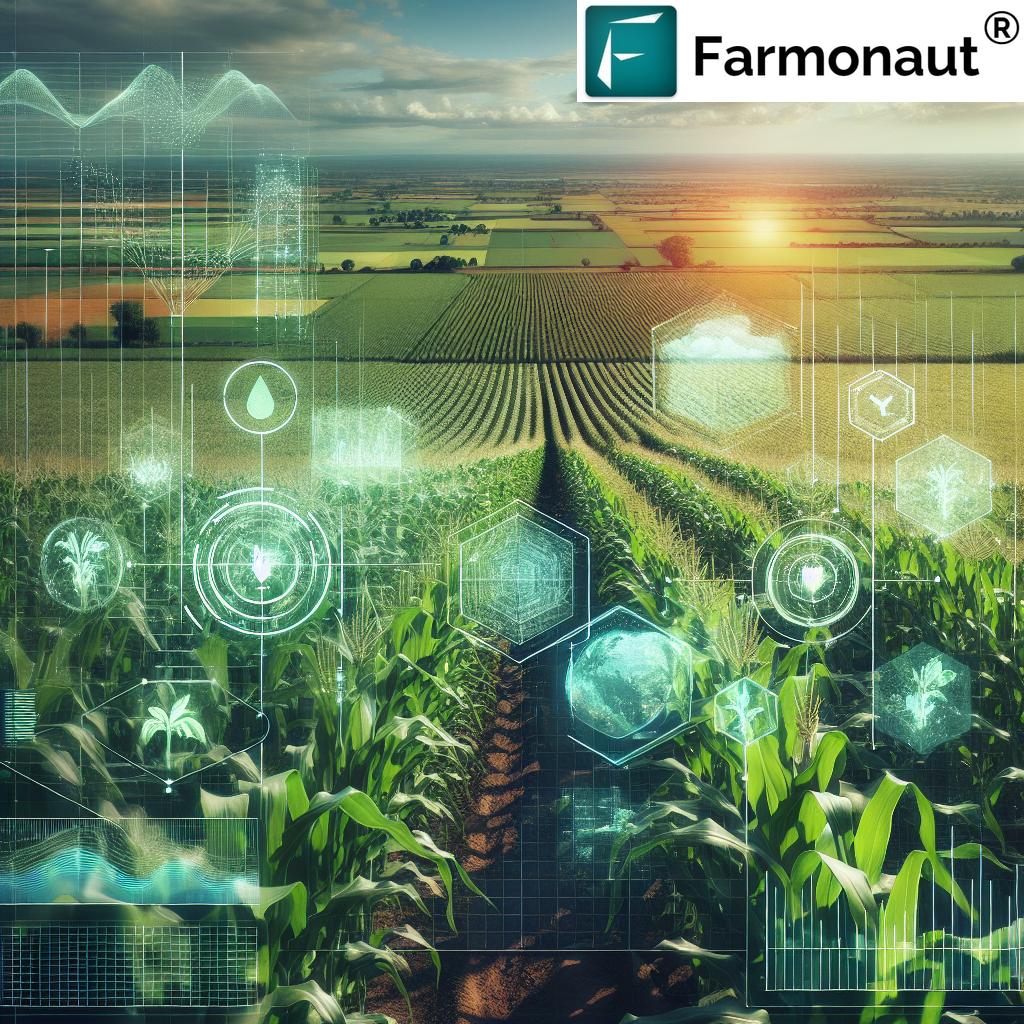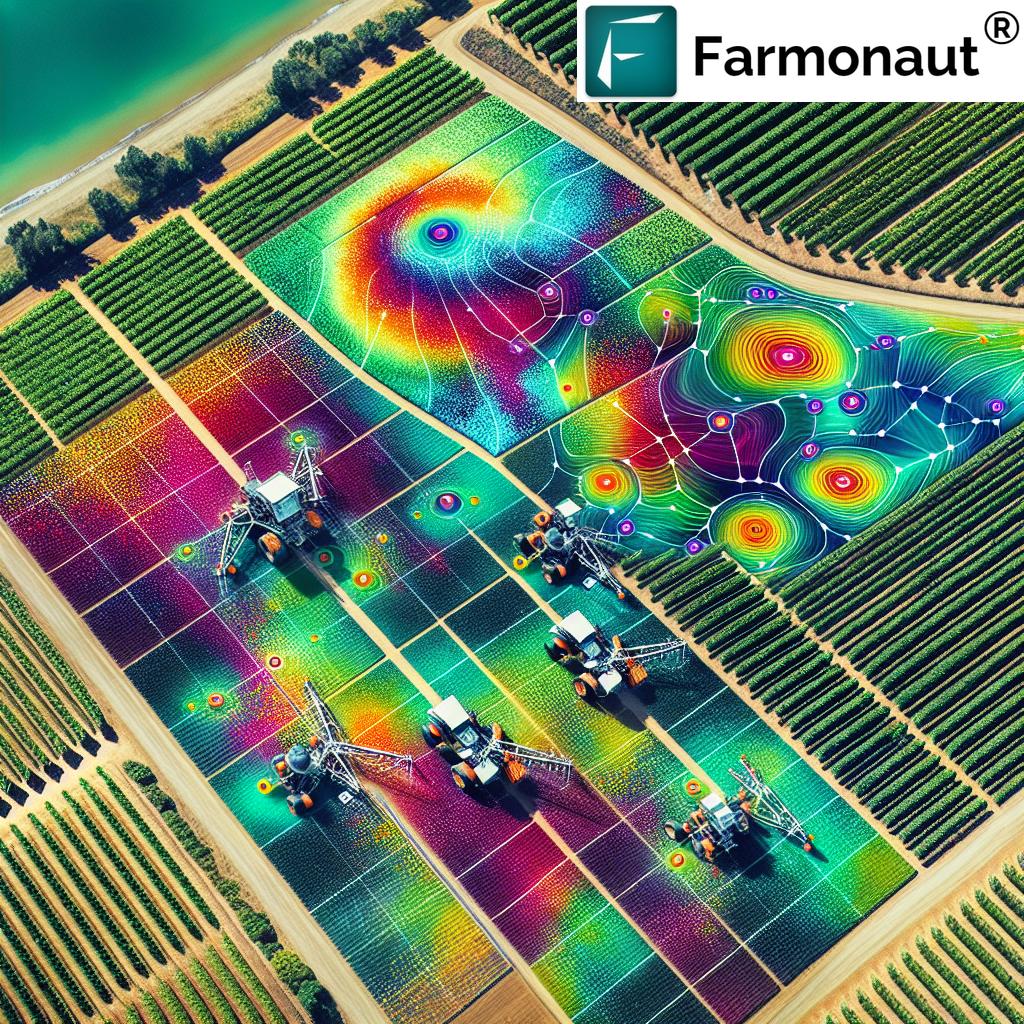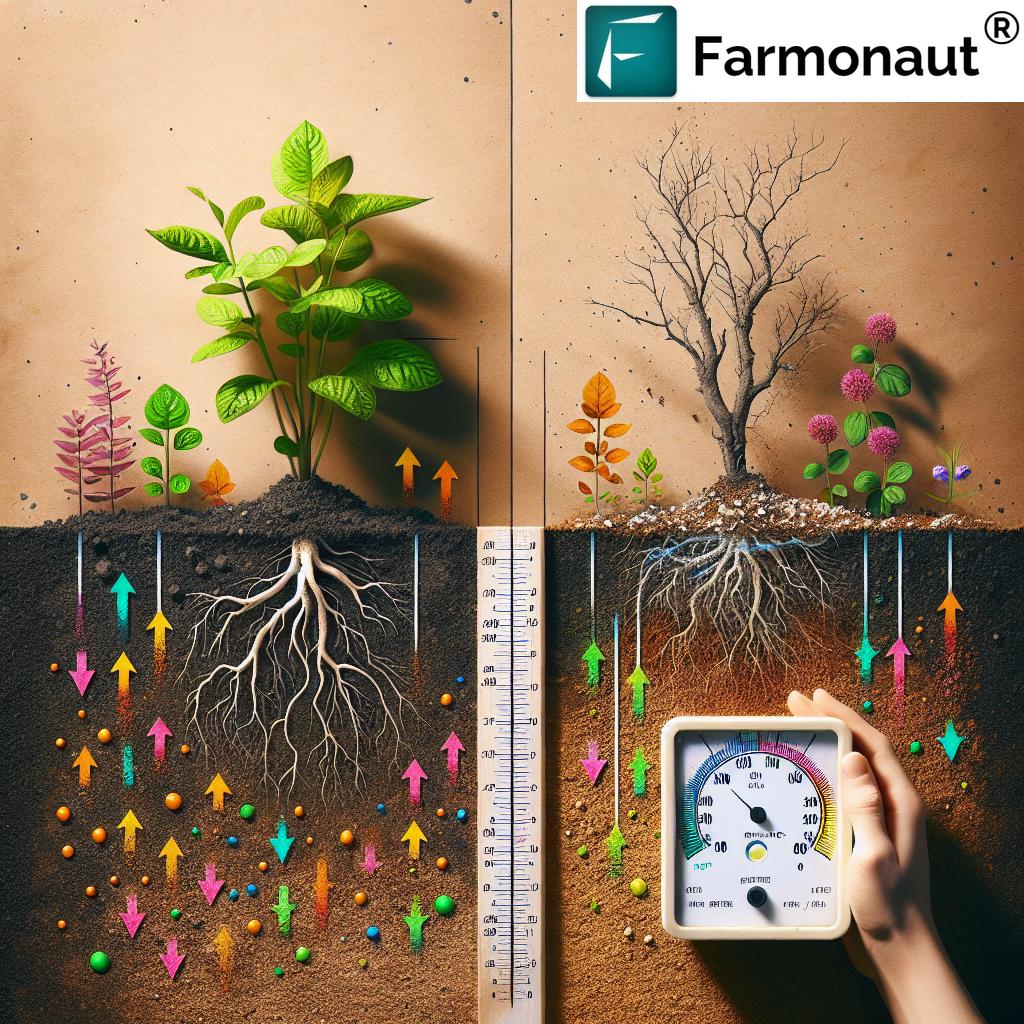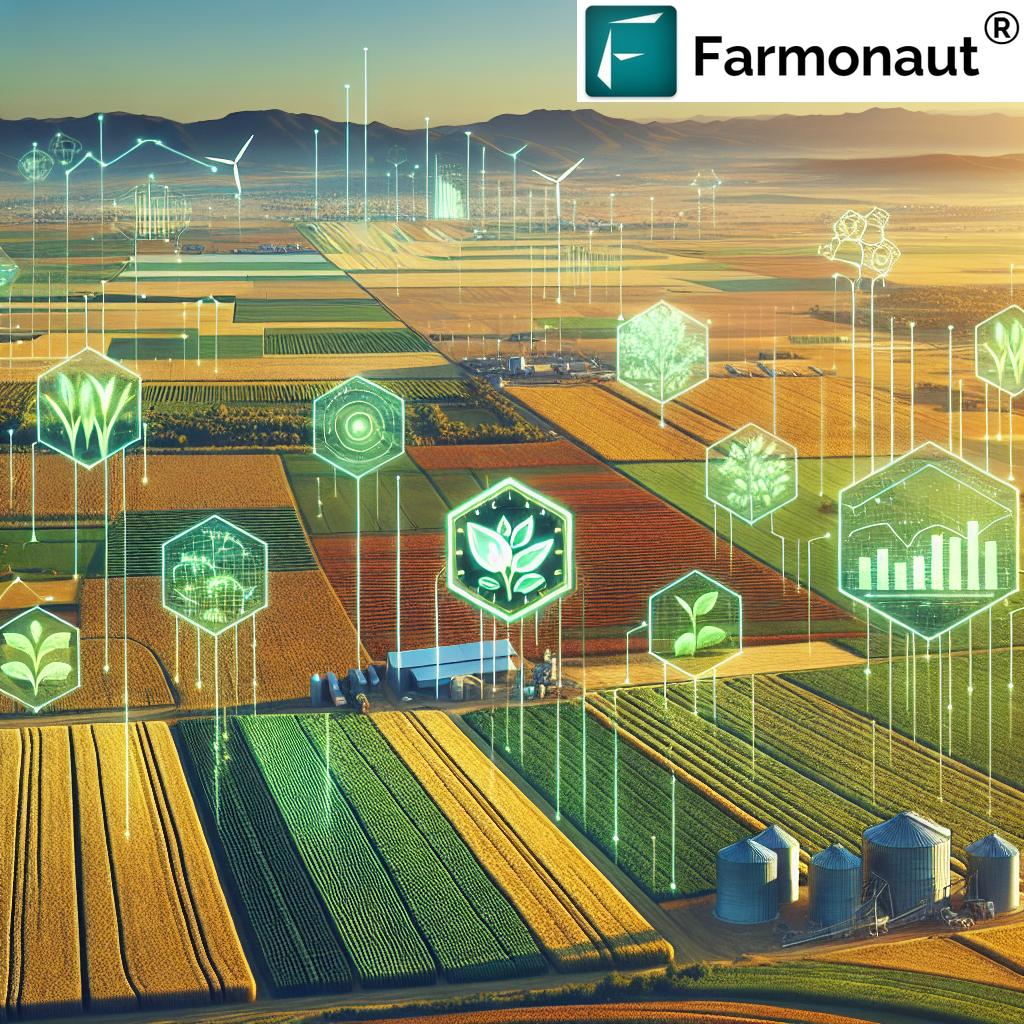Maximize Farm Efficiency: Essential Guide to Precision Agriculture Technology and Smart Farming Systems with Farmonaut
“Precision agriculture technology can increase crop yields by up to 30% while reducing water usage by 20-50%”
Welcome to our comprehensive guide on maximizing farm efficiency through precision agriculture technology and smart farming systems. In this blog post, we’ll explore how innovative solutions like those offered by Farmonaut are revolutionizing the agricultural landscape. From essential lawn mower maintenance tips to advanced precision planting techniques, we’ll cover a wide range of topics to help you optimize your farming operations.
The Evolution of Farming: Traditional vs. Precision Agriculture
Before we dive into the specifics of precision agriculture technology, let’s take a moment to understand how it differs from traditional farming methods. This comparison will help illustrate the significant advantages that smart farming systems can bring to your agricultural endeavors.
| Aspect | Traditional Farming | Precision Agriculture with Farmonaut |
|---|---|---|
| Field Monitoring | Periodic manual inspections | Daily satellite imagery analysis |
| Resource Management | Uniform application across fields | Targeted, variable-rate application |
| Yield Prediction | Based on historical data and experience | AI-driven predictions using real-time data |
| Pest and Disease Detection | Visual inspections, often reactive | Early detection through spectral analysis |
| Irrigation Management | Scheduled, uniform watering | Precision irrigation based on soil moisture data |
| Overall Efficiency | Variable, dependent on experience | Up to 30% increase in crop yield, 20-50% water savings |
As we can see from this comparison, precision agriculture with Farmonaut offers significant advantages over traditional farming methods. By leveraging advanced technologies like satellite imagery, AI, and real-time data analysis, farmers can make more informed decisions, optimize resource use, and ultimately increase their yields while reducing environmental impact.
Embracing Precision Agriculture Technology
Precision agriculture technology is at the heart of modern farming practices. It allows farmers to make data-driven decisions, optimize resource allocation, and increase overall productivity. Let’s explore some key aspects of this technology and how Farmonaut is making it accessible to farmers worldwide.
Satellite-Based Crop Health Monitoring
One of the cornerstone technologies in precision agriculture is satellite-based crop health monitoring. Farmonaut utilizes multispectral satellite images to provide farmers with crucial insights into their crops’ health and development. This technology offers several benefits:
- Real-time vegetation health (NDVI) monitoring
- Soil moisture level analysis
- Early detection of crop stress and disease
- Optimization of irrigation and fertilizer usage
By leveraging this technology, farmers can identify issues before they become visible to the naked eye, allowing for proactive management and potentially saving entire crops from devastating losses.

AI-Powered Farm Advisory Systems
Artificial Intelligence (AI) is revolutionizing the way farmers approach crop management. Farmonaut’s Jeevn AI Advisory System is a prime example of how AI can be harnessed to provide personalized, real-time advice to farmers. This system offers:
- Customized crop management strategies
- Weather forecasts and alerts
- Pest and disease risk assessments
- Recommendations for optimal planting and harvesting times
By integrating AI into farming practices, we can significantly reduce guesswork and improve decision-making processes, leading to more efficient and productive agricultural operations.
Precision Planting and Seeding Techniques
Precision planting and seeding are crucial aspects of modern agriculture that can significantly impact crop yields and resource efficiency. With the help of GPS-guided equipment and variable-rate technology, farmers can:
- Optimize seed placement and spacing
- Adjust seeding rates based on soil conditions
- Reduce seed waste and improve germination rates
- Enhance overall crop uniformity
These advanced techniques not only improve crop yields but also contribute to more sustainable farming practices by minimizing resource waste.
Smart Farming Systems: The Future of Agriculture
Smart farming systems integrate various technologies to create a comprehensive, data-driven approach to agriculture. These systems leverage the power of the Internet of Things (IoT), big data analytics, and automation to optimize every aspect of farming operations.
IoT in Agriculture
The Internet of Things (IoT) has found numerous applications in agriculture, enabling farmers to collect and analyze data from various sources across their farms. Some key applications include:
- Soil sensors for monitoring moisture, temperature, and nutrient levels
- Weather stations for localized climate data
- GPS-enabled equipment for precise navigation and data collection
- Smart irrigation systems for water conservation
By connecting these devices and sensors, farmers can create a comprehensive picture of their farm’s conditions and make informed decisions based on real-time data.
Big Data Analytics in Farming
The vast amount of data collected through IoT devices and satellite imagery requires sophisticated analysis to be truly useful. Big data analytics in agriculture helps farmers:
- Identify patterns and trends in crop performance
- Predict potential issues before they occur
- Optimize resource allocation based on historical and real-time data
- Make data-driven decisions for improved farm management
Farmonaut’s platform leverages these analytics capabilities to provide farmers with actionable insights, helping them make the most of their data.

Automation in Agriculture
Automation is playing an increasingly important role in modern farming, helping to address labor shortages and improve efficiency. Some key areas of agricultural automation include:
- Autonomous tractors and other farm machinery
- Robotic harvesting systems
- Automated irrigation and fertigation systems
- Drone technology for crop monitoring and spraying
While Farmonaut doesn’t directly provide these automation technologies, its satellite monitoring and AI advisory systems can complement and enhance the effectiveness of automated farming equipment.
Sustainable Agriculture Practices
Sustainability is a crucial concern in modern agriculture, and precision farming technologies play a significant role in promoting environmentally friendly practices. Let’s explore how Farmonaut’s solutions contribute to sustainable agriculture:
Resource Conservation
One of the key benefits of precision agriculture is its ability to optimize resource use. Farmonaut’s satellite-based monitoring helps farmers:
- Reduce water usage through precise irrigation management
- Minimize fertilizer and pesticide application by targeting specific areas
- Decrease fuel consumption by optimizing equipment routes and operations
These practices not only reduce the environmental impact of farming but also help lower operational costs for farmers.
Carbon Footprint Tracking
As climate change concerns grow, monitoring and reducing carbon emissions has become increasingly important in agriculture. Farmonaut offers carbon footprint tracking features that allow agribusinesses to:
- Monitor real-time emissions data
- Identify areas for potential emission reductions
- Comply with environmental regulations
- Work towards more sustainable farming practices
By providing this data, Farmonaut empowers farmers and agribusinesses to take concrete steps towards reducing their environmental impact.
Biodiversity Preservation
Precision agriculture can also contribute to biodiversity preservation by:
- Reducing the need for chemical inputs that can harm beneficial insects and soil microorganisms
- Minimizing soil erosion through targeted cultivation practices
- Promoting crop rotation and diversification based on data-driven insights
These practices help maintain a healthy ecosystem on and around farms, supporting long-term agricultural sustainability.
Essential Farm Machinery Maintenance
“Proper lawn mower maintenance can extend its lifespan by 50% and reduce fuel consumption by up to 25%”
While precision agriculture technologies are transforming farming practices, proper maintenance of traditional farm machinery remains crucial for efficient operations. Let’s look at some essential maintenance tips for common farm equipment:
Lawn Mower Maintenance
Regular maintenance of your lawn mower is essential for its longevity and performance. Here are some key steps:
- Change the oil and oil filter regularly
- Sharpen and balance the blades
- Clean or replace the air filter
- Check and replace spark plugs as needed
- Inspect and clean the deck
Here’s a helpful video on how to change the engine oil and oil filter:
Tractor Maintenance
Tractors are the workhorses of many farms, and proper maintenance is crucial for their reliability and efficiency:
- Regularly check and change fluids (engine oil, transmission fluid, coolant)
- Grease all fittings and moving parts
- Inspect and maintain tire pressure
- Clean or replace air and fuel filters
- Check and adjust belt tensions
Implement and Attachment Care
Proper care of tractor attachments and implements is essential for their longevity and performance:
- Clean implements thoroughly after use
- Inspect for wear and damage, replacing parts as needed
- Lubricate moving parts according to manufacturer recommendations
- Store implements properly when not in use, protecting them from the elements
Agricultural Equipment Safety
Safety should always be a top priority when working with farm machinery. Here are some essential safety tips:
- Always read and follow the operator’s manual for each piece of equipment
- Wear appropriate personal protective equipment (PPE)
- Conduct pre-operation inspections of equipment
- Be aware of your surroundings and potential hazards
- Never operate machinery while fatigued or under the influence of alcohol or drugs
Here’s a video demonstrating how to perform a pre and post-mow inspection:
Integrating Farmonaut into Your Farming Operations
Now that we’ve covered the basics of precision agriculture and farm machinery maintenance, let’s explore how you can integrate Farmonaut’s solutions into your farming operations.
Getting Started with Farmonaut
To begin using Farmonaut’s satellite-based farm management solutions, follow these steps:
- Sign up for a Farmonaut account through their web app or mobile application
- Add your farm for satellite monitoring
- Explore the various features and tools available on the platform
- Integrate the insights into your decision-making process
Here’s a video tutorial on how to add your farm for satellite monitoring using the Farmonaut mobile app:
Utilizing Satellite Data for Farm Management
Once you’ve set up your farm on Farmonaut, you can start leveraging satellite data for various aspects of farm management:
- Monitor crop health using vegetation indices like NDVI
- Track soil moisture levels to optimize irrigation
- Identify areas of stress or potential disease outbreaks
- Plan fertilizer and pesticide applications more efficiently
Here’s a tutorial on how to check detailed satellite reports of your farm using the Farmonaut mobile app:
Integrating AI Advisories into Your Workflow
Farmonaut’s Jeevn AI Advisory System can provide valuable insights to enhance your farming practices:
- Review daily AI-generated advisories for your specific crops and field conditions
- Incorporate weather forecasts and alerts into your planning
- Use pest and disease risk assessments to guide your crop protection strategies
- Optimize planting and harvesting schedules based on AI recommendations
Financing and Protection for Your Agricultural Investments
Investing in precision agriculture technology and farm machinery can be significant. Here are some considerations for financing and protecting your investments:
Equipment Financing Options
- Explore leasing options for expensive machinery
- Consider low-interest agricultural loans from banks or credit unions
- Look into government-backed financing programs for farmers
- Investigate manufacturer financing options for new equipment purchases
Warranty and Protection Plans
To safeguard your investments in farm equipment and technology:
- Understand and utilize manufacturer warranties
- Consider extended protection plans for high-value equipment
- Explore insurance options for precision agriculture technology
- Keep detailed maintenance records to support warranty claims
Conclusion: Embracing the Future of Agriculture
As we’ve explored in this comprehensive guide, the integration of precision agriculture technology and smart farming systems is revolutionizing the agricultural landscape. From satellite-based crop monitoring to AI-driven advisories, these innovations are helping farmers maximize efficiency, increase yields, and promote sustainability.
By combining these advanced technologies with proper maintenance of traditional farm machinery, farmers can create a powerful synergy that drives productivity and profitability. Farmonaut’s platform offers an accessible entry point into the world of precision agriculture, providing valuable tools and insights that can benefit farms of all sizes.
As you consider implementing these technologies on your farm, remember that the journey towards precision agriculture is ongoing. Start small, experiment with different tools and techniques, and gradually integrate more advanced solutions as you become comfortable with the technology.
Ready to take the next step in your precision agriculture journey? Explore Farmonaut’s solutions and start transforming your farming practices today:
For developers interested in integrating Farmonaut’s satellite and weather data into their own applications, check out the Farmonaut API and the API Developer Docs.
Farmonaut Subscription Plans
Frequently Asked Questions (FAQ)
Q: What is precision agriculture?
A: Precision agriculture is a farming management concept that uses technology to observe, measure, and respond to variability in crops. It involves using tools like satellite imagery, GPS guidance, and sensors to optimize crop yields and reduce resource waste.
Q: How does Farmonaut’s satellite monitoring work?
A: Farmonaut uses multispectral satellite imagery to analyze crop health, soil moisture, and other key metrics. This data is processed and presented to farmers through user-friendly web and mobile applications, providing valuable insights for farm management.
Q: Can Farmonaut’s solutions be used for small farms?
A: Yes, Farmonaut’s platform is designed to be scalable and accessible for farms of all sizes. Whether you’re managing a small garden or a large agricultural operation, you can benefit from the insights provided by Farmonaut’s technology.
Q: How often is satellite data updated on Farmonaut?
A: The frequency of satellite data updates can vary depending on your subscription plan and location. Generally, Farmonaut provides regular updates every few days, ensuring you have access to timely information about your crops.
Q: Is an internet connection required to use Farmonaut’s mobile app?
A: While an internet connection is needed to receive the latest satellite data and AI advisories, some features of the mobile app may be available offline. However, for the most up-to-date information, a reliable internet connection is recommended.
By embracing precision agriculture technology and smart farming systems, you’re not just improving your farm’s efficiency – you’re becoming part of a global movement towards more sustainable and productive agriculture. Let Farmonaut be your partner in this exciting journey towards the future of farming.


